I recently traveled to Fukushima prefecture in the Tohoku region of Japan. At the time of my visit there was heavy snow, but I could still recognize that Fukushima is extraordinarily beautiful whatever the season. The high mountain ranges mixed with vast flat plateaus give the region breathtaking scenery. There is much of old Japan remaining here, even in the modern towns, and it doesn't take long after leaving a town to feel like you are deep in the countryside.
The first stop on my trip was Tsuruga castle, also known as Aizu-Wakamatsu Castle. This impressive seven story castle towers over other buildings in the surrounding area and can be easily seen from nearby mountains and hills. A castle has been on this site since 1384 when the first castle was built here by Ashina Naomori. The castle has gone through various reconstructions in its history, including having seven stories at one time. However, in 1611 it was damaged by a major earthquake and rebuilt into a five story version. Later, during the Boshin war in 1868, the castle suffered heavy bombardment from the imperial forces during a month long seige and eventually had to be demolished in 1874. The current castle was reconstructed in 1965 using the last known photograph of the damaged castle as a reference. The reconstruction project was largely funded and supported by the people of Aizu-Wakamatsu. Presently, it also functions as a museum, and since 2011, is the only castle in Japan to have a red roof.
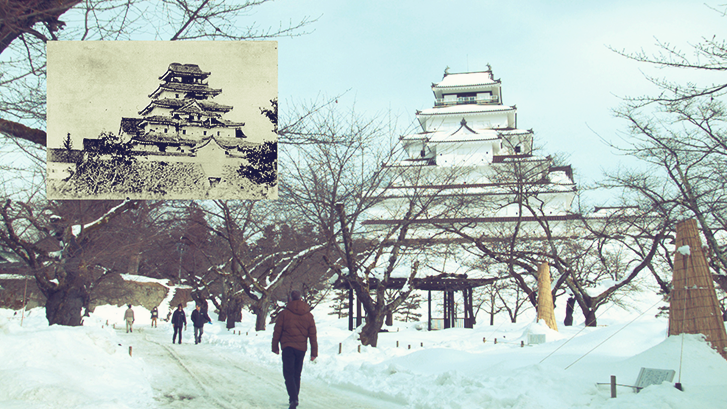 Tsuruga Castle in Aizu-Wakamatsu (with insert of original damaged castle)
Tsuruga Castle in Aizu-Wakamatsu (with insert of original damaged castle)
Not too far from Tsuruga castle is Iimori Hill. On Iimori hill is a monument and the graves of twenty teenage members of a samurai youth military support unit called the Byakkotai (White Tiger Brigade). During the Battle of Tonoguchihara, in the Boshin war, they became seperated from the rest of their unit and decided to retreat to Iimori hill. They evaded the imperial forces and arrived there safely by wading up to their necks in water through the Takizawa pass (a small dark tunnel). When they reached the point on the hill where they could view the town to assess the situation, due to the many fires and considerable smoke in the town, they mistakenly thought that their Lord's castle was on fire. Thinking that all was lost, they made the decision to commit seppuku, or ritual suicide on the spot.
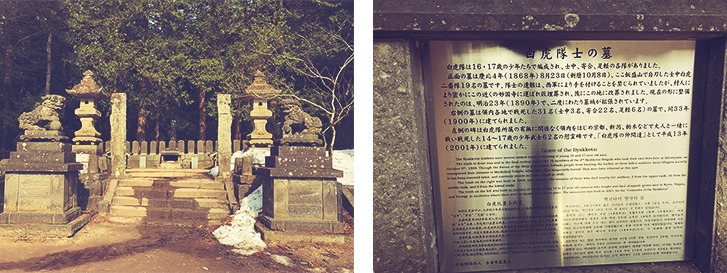 Monument and graves of the Byakkotai
Monument and graves of the Byakkotai
One member, Iinuma Sadakichi, who was only fourteen at the time survived. He was discovered and saved by the wife of a samurai. It was only because of his survival that the story of the twenty brave young samurai was able to be recounted. Every year on April 24th and September 24th memorial ceremonies by digitaries and special performances called kenbu by high school students from Aizu-Wakamatsu are made in front of the grave site. There are tributes to the Byakkotai from all over Japan and the world. A memorial with a poem by the ninth and last lord of Aizu, Matsudaira Katamori is situated nearby, No matter how many people wash the stones with their tears, these names will never vanish from the world. Close to the grave site is the Byakkotai Kinenkan, a small museum with artifacts related to the Byakkotai and the Boshin war.
 Kenbu performance
Kenbu performance
The Shinsengumi Kinenkan is a small museum in Nanuka-machi, Aizu-Wakamatsu. It also has many relics and artifacts from the Boshin war, as well as information and photographs of members of the Shinsengumi. The Shinsengumi were a band of swordsmen who were employed by the shogunate in the tumoil of the Bakumatsu era to police an increasingly violent Kyoto. Around the same time, the ninth Lord of Aizu, Matsudaira Katamori, was appointed Military commissioner of Kyoto and the band of swordsmen fell under his command. Originally the group went through several name changes, before it was finally named the Shinsengumi (Newly Selected Corps). It is said that it was Katamori who gave them the name after reassigning their duties in Kyoto. From this time onwards, united in their sincerity, a bond was formed between members of the Shinsengumi and the Aizu clan.
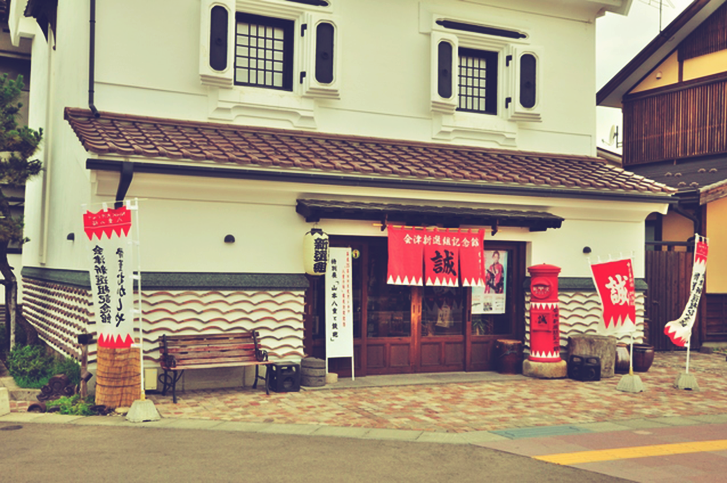 Shinsengumi Kinenkan in Nanuka-machi, Aizu-Wakamatsu.
Shinsengumi Kinenkan in Nanuka-machi, Aizu-Wakamatsu.
There are reports that swords were given to the Shinsengumi by the Aizu clan. It is also said that the Shinsengumi vice-commander, Hijikata Toshizo, owned a sword by famed Aizu swordsmith, the eleventh generation Aizu Kanesada. Hijikata Toshizo also spent time in Aizu recouperating from battle injuries before setting off to fight in Hokkaido. After Kondo Isami was beheaded as a rebel in Itabashi (Tokyo), his head was transported to Kyoto as proof. However, it is said that someone from Aizu secretly took his head and sword back from Kyoto and buried his head in Tennei Temple in Aizu-Wakamatsu. Nowadays, there is a monument to the fallen of the Boshin War, and a separate gravestone dedicated to Kondo there. Another member of the Shinsengumi, Saito Hajime, went to Aizu after the Battle of Koshu-Katsunuma and remained with the clan even after Aizu's defeat.
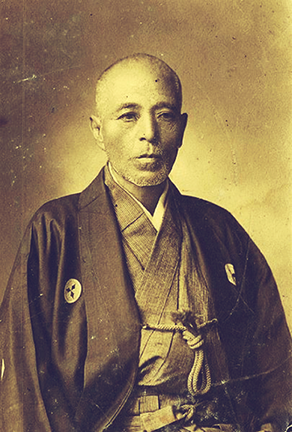 Saito Hajime, captain of the third Shinsengumi unit.
Saito Hajime, captain of the third Shinsengumi unit.
Nisshinkan was an academy, established in 1803, for the children of high ranking samurai in the Aizu clan. Children would enter at the age of ten years old, and graduate at fifteen. It was said to usually have an average of 1000 to 1300 students, and was widely known throughout Japan for its excellent educational standards. Classes would begin at 8 am, and the children would not only perform academic studies, but also learn about samurai etiquette, and be trained in martial arts. Several members of the Byakkotai also graduated from here. Unfortunately, the original building was burned down during the Boshin war but was meticulously reconstructed in 1987.
 Nisshinkan Academy for Aizu samurai in Aizu-Wakamatsu.
Nisshinkan Academy for Aizu samurai in Aizu-Wakamatsu.
Ouchi-juku is a small Edo period post village in Shimogo. The village has been there for at least three-hundred years and was used as a rest stop for travelers traveling along the Aizu Nishi-Kaido road when they were either on their way to Edo (Tokyo), or from Aizu to Niigata. It was also commonly used for samurai who were travelling to Edo during the time of the Sankin-Kotai system in the fuedal period where members of prominent samurai families would have to stay at their residences in Edo for extended periods of time. Then a party of their clan would come and exchange them for other members every two years.
This village of traditional thatched roof Japanese cottages, punctuated by the odd kura, or store house, has been preserved in its original condition from the late Edo period, and has been designated as the Japanese eqivalent of a National Heritage site (Dentōteki Kenzobutsu-gun: Important Group of Traditional Buildings). There are small shops there and a some traditional Japanese minshuku (Inn). Just off to the side of the main village on a hill is a small picturesque Shinto shrine called Takakura Jinja.
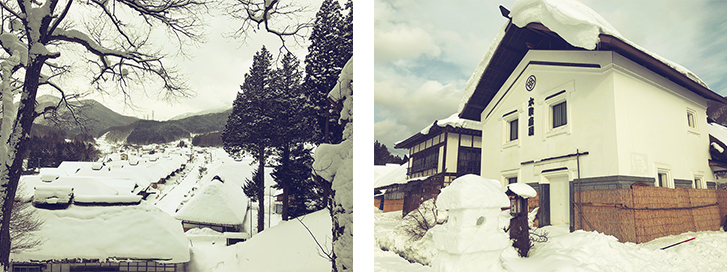 Ouchi-juku, Shimogo.
Ouchi-juku, Shimogo.
One cannot talk about feeling the samurai spirit in Fukushima without experiencing Soma city and the Soma-nomaoi. Soma city is very close to the coast in northeastern Fukushima with a major port. The area was home to the Soma samurai clan who were centered around Soma-Nakamura castle (also known as Mutsu-Nakamura castle), who had been in the area since from the Kamakura period (1185-1332) right up until the Boshin war (1868). The main part of the castle was taken down in the Meiji period, but the surrounding grounds, gates, and buildings remain.
The Soma-nomaoi is an annual festival with over a thousand year old history, and is still presided over by the current head of the Soma family. It has been designated by the government as an Important Intangible Folk Cultural Property. It is a series of samurai and horse related events that take place every year, beginning on the last Friday of July. On the first day of the festival, a procession takes place with many of the riders clad in samurai armor and wearing white bandanas assembling at the Soma Nakamura shrine to pray for safety during the events. The next day (Saturday), the riders once again assemble at the shrine to collect a portable shrine that will be present at the events. They sing a traditional warriors song called, Soma Nagareyama, before escorting the portable shrine to the event grounds. A procession of riders wearing samurai armor and other people in traditional Japanese clothing follow behind the shrine while music is played on a conch shell and drums.
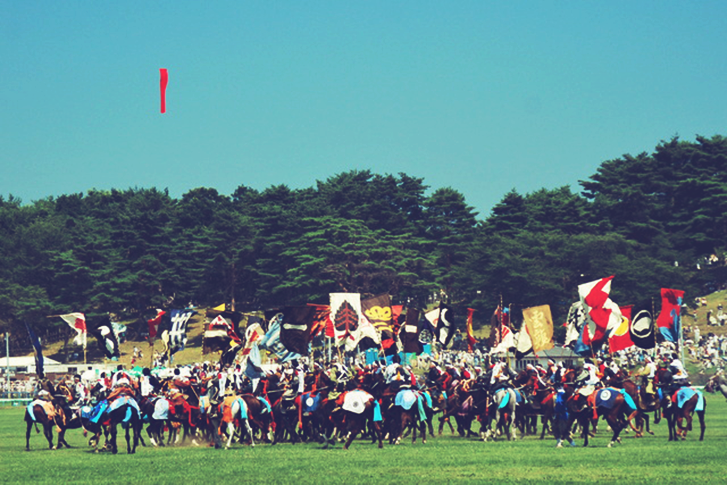 Soma-nomaoi
Soma-nomaoi
On the Sunday, three main horse events take place. The first is the Katchu Keiba, or armored horse race. This is followed by the wild looking event of the Shinki Sodatsusen, where scores of mounted samurai scramble to try be first to obtain a sacred flags that are shot into the air. This is followed the returning procession to replace the portable shrine in the main shrine. The final event is on the Monday at Soma Odaka shrine, and is called the Nomagake, also known as the wild horse chase. A wild riderless horse is released, and a large group of young men on foot, have to chase and catch it. The whole event is an amazingly exciting experience that make you feel as if you are in a time slip. If you are a fan of samurai, this is one event on one of your trips to Japan that should not be missed.
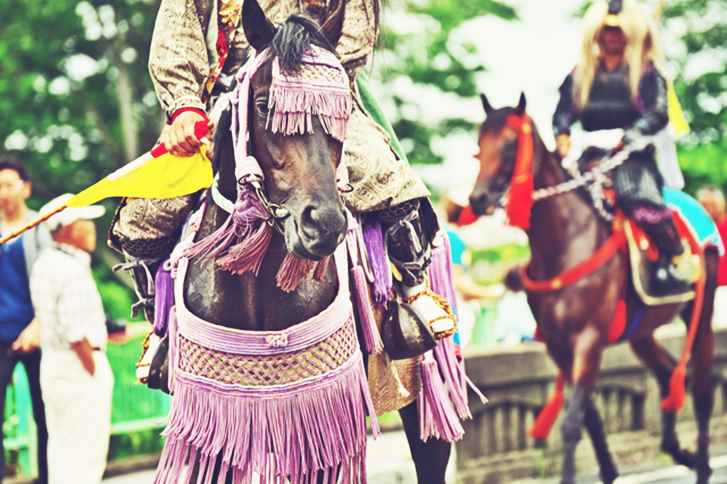 Soma-nomaoi
Soma-nomaoi
If you want to feel the samurai spirit of the Edo period, you should visit Fukushima. There are many wonderful places where you can sense the atmosphere of a bygone age and feel the spirit of the samurai that still exists in the people of Fukushima today.







